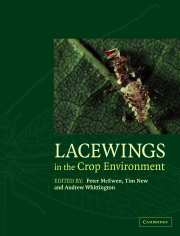CHAPTER 31 - Lacewings in crops: towards the future
Published online by Cambridge University Press: 04 May 2010
Summary
In this book we have brought together some of the numerous studies which address the importance of lacewings in the crop environment; sufficient, we hope, to demonstrate the wide variety of contexts in which their values as predators are acknowledged and exploited, and that sound scientific understanding of the biology of individual taxa is critical in facilitating and extending their use. Lacewings have long been appreciated as predators, and some of the cases presented here exemplify the subtleties and innovations needed to increase their impacts. The variety of themes included constitutes a contemporary ‘state-of-the-art’ summary of the perceived roles of lacewings in crops. The constraints under which integrated pest control using polyphagous (generalist) natural enemies must proceed are also evident.
Lacewings are not as well understood as some other groups of predatory insects on crops, particularly ladybirds (Coleoptera: Coccinellidae). However, the widely distributed species of Chrysoperla, in particular, may be ranked among the most widespread and popular predators of small arthropods in many crop contexts. Yet, in many parts of the world other taxa are coming to play their part. Chrysoperla does not occur in Australia or New Zealand, for example, and such generalist predators would be highly unlikely to be approved for introduction there. Emphasis on diversifying the options for pest management must then focus on native species, and such additional studies (in many parts of the world) are expanding our appreciation of lacewings as versatile predators in an increasingly diverse arena.
However, it must be accepted – despite widespread evangelism to the contrary – that the spectrum of Neuroptera likely to be employed and manipulated in crop pest management is likely to remain small.
- Type
- Chapter
- Information
- Lacewings in the Crop Environment , pp. 521 - 522Publisher: Cambridge University PressPrint publication year: 2001



